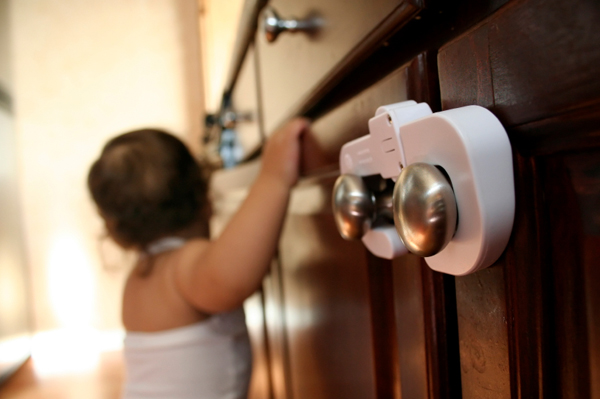Baby-proofing Checklist
Bath spout cover: bathtubs can be very slippery, so attaching a cover to the bath spout can save you a lot of tears and injuries
 |
| Photo |
Nonslip bath mat: just be sure to hang it up after you use it so it doesn't get yucky and moldy
Toilet lock: your child probably won't yet understand why he can't play with the water in the toilet bowl... after all, mommy and daddy drink water, so it must be okay
| Photo |
Corner guards for sharp-edged furniture: this is an absolute must-have, especially if you have a coffee table or dining room table with sharp edges... in 2009, just over 143,000 children age 5 and under visited emergency rooms after accidents with tables
Outlet plugs and/or sliding outlet plates: this one is obvious... no one wants the baby sticking her finger or any object (especially a metal one) in the wall socket and getting electrocuted
| Photo |
Power strip covers: even if these aren't in a room that your baby has access to, it's still probably a good idea to use them
Cabinet locks: this will keep cleaning supplies and other hazardous chemicals locked away and out of the baby's mouth, as well as preventing them from pulling anything out of the cupboard on top of himself or breaking things in the cupboard
Drawer locks: same thing, keeps the baby from getting into things she's not supposed to touch, like knives or pens/pencils/markers
Safety gates: these are good for keeping the baby out of off-limits rooms and from falling down or crawling up (and then falling down) any staircases in your home
 |
| Photo |
Secure furniture to the wall if it can fall or be pulled over: this includes bookshelves, TV cabinets, and so forth
Anti-tip straps for flat-screen TV's: if you don't have a flat-screen, you don't have to worry about this, but if you do, you need to take precautions so your child cannot pull the TV down on to his head
Cord shorteners for blinds and curtains: babies can easily strangle themselves in these cords or (at best) cause damage to your blinds by messing around with them, so keep them out of reach
 |
| Photo |
Window locks: Babies falling out of windows, even low ones, can result in serious injury, and is a shockingly common occurrence
Door locks and/or doorknob covers: these can keep your baby out of off-limits rooms, and is an easier alternative to a baby gate
Oven latch: the oven is full of things to explore... and ways to get hurt, so keep your baby from being able to open the oven with a latch
Oven knob covers: this keeps your baby from accidentally turning on your gas or electric stove and burning or otherwise injuring herself
 |
| Photo |
Fridge latch: because who wants to walk into the kitchen to find the baby climbing the shelves, breaking things, and getting hurt?
Adjust water heater to 120°F maximum to prevent burns
Carbon monoxide and smoke detectors: these should be present in all homes, even ones without children and babies
Anti-slip treads/carpeting on stairs: this is another good one for any household, as it can be fairly easy to slip on the stairs and cause serious injury, regardless of age
Baby-proof any electronics that your child might have access to, or keep them somewhere that he can't get to them (laptops, computers, cords, etc.)
What other ways have you baby-proofed your home? Please share any other ideas or let us know if we missed anything important!
 |
| Photo |
Hellobee
New York Times

No comments:
Post a Comment